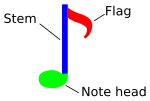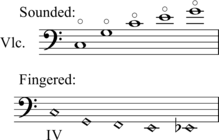
Back Notenkopf German Kapo (muziko) Esperanto Cabeza de nota Spanish Tête de note French 符頭 Japanese Нотна глава Macedonian Notehode NB Головка (нотная грамота) Russian Notna glava Serbo-Croatian Нотна глава Serbian






In music, a notehead is the part of a note, usually elliptical in shape, whose placement on the staff indicates the pitch, to which modifications are made that indicate duration. Noteheads may be the same shape but colored completely black or white, indicating the note value (i.e., rhythmic duration). In a whole note, the notehead, shaped differently than shorter notes, is the only component of the note. Shorter note values attach a stem to the notehead, and possibly beams or flags. The longer double whole note can be written with vertical lines surrounding it, two attached noteheads, or a rectangular notehead.[1] An "x" shaped notehead may be used to indicate percussion, percussive effects (ghost notes), or speaking. A square, diamond, or box shaped notehead may be used to indicate a natural or artificial harmonic. A small notehead can be used to indicate a grace note.
- ^ Gerou, Tom & Lusk, Linda: Essential Dictionary of Music Notation. Alfred Music, 1996, p. 210.
© MMXXIII Rich X Search. We shall prevail. All rights reserved. Rich X Search